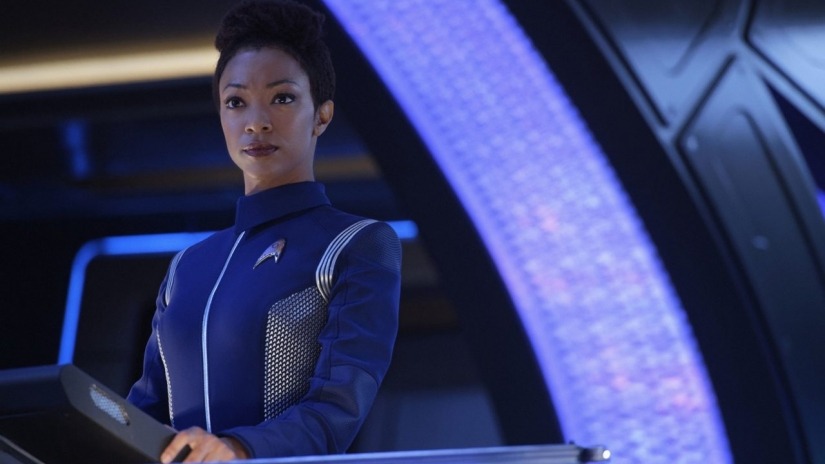This review contains spoilers.
2.2 New Eden
It’s time for another away mission, y’all! We’ve been waiting for this moment since last season’s Si Vis Pacem, Para Bellum, the only other Star Trek: Discovery episode so far to feature that old Trek episode structure standby that sees a group of Federation crew members heading down to a planet for some shenanigans.
In this case, the planet is Terralisia, a “surprisingly Earth-like” globe on the other side of the galaxy with a small human population that has been unknowingly sending the same distress message on repeat for the last 200 years. The group of Federation crew members is Burnham, Pike, and Lieutenant Owosekun, who finally gets to leave the bridge, but, sadly, is still in search of some actual character development.
The Discovery travels to the planet as part of their ongoing mission to figure out what the heck the red signals mean. Upon reaching Terralisia and chatting with some of the planet’s citizens (under the guise of being visitors from one of the settlements to the north, obviously), they learn that the people there were brought to the planet seemingly by one of the red signals—they saw the same angelic outline Michael did on the asteroid.
It’s the first time that I’ve really cared about the mystery of the red bursts. The mysterious signal transported the human ancestors of the people who now live on Terralisia from the ashes of Earth’s World War III to the other side of the galaxy. This happened more than 200 years ago, which broadens the mystery of the red signals not only across massive amounts of space, but across centuries of time. (Sure, Spock has apparently seen visions of the red bursts since he was a kid, but that’s nothing compared to centuries…)
The away mission to Terralisia is an opportunity for Discovery to explore one of its richest thematic dilemmas: The Prime Directive, known here as General Order One. General Order One is a non-interference directive that states members of the Federation cannot interfere with the normal development of any pre-warp civilisation and, throughout the history of Star Trek canon, has been used by the plot in various ways.
It often pits different characters against one another, and asks semi-explored questions about the Federation as a colonial force. Here, we see Michael on the opposite side from Pike. She sympathises with Jacob, a man on Terralisia who immediately suspects the away party is from Earth, which would mean that Earth wasn’t destroyed in World War III, as this planet suspects.
Michael wants to tell Jacob the truth, but Pike refuses. Even though these people are humans, they left Earth before warp was invented, which means they are technically pre-warp. Jacob begs for them to tell him the truth, but they do not… Not even Burnham. The away team returns to Discovery to help an injured Pike, no closer to discovering the truth of the red signal.
That is until Pike and Burnham have a heart-to-heart. Michael convinces Chris to make an exchange with Jacob: the truth (and a battery) for a camera that recorded the moment the Terralisan’s ancestors were rescued from Earth. It doesn’t give us much to go on, only showing that the ancestors saw an angel-like vision before the entire church they were in was transported to another planet. OK. Colour me intrigued.
While the away team is on the surface, the Discovery, under the command of Saru, is working to save the planet below from an apocalyptic event. They use their combined know-how, with a particularly helpful plan from Tilly, to save the day. Along with the away mission, this kind of collaborative teamwork that was mostly missing from the first season (especially on the bridge) felt very Trek-y.
In general, Saru was the kind of Federation captain Jean Luc Picard would be proud of. When Tilly injures herself taking a sample from the dark matter rock currently floating in one of the Discovery’s bays, Saru gives her a talking to. “Before we care for others, we must care for ourselves,” he tells her. “You’re important.” It was easily one of the best moments of the episode and, at least for me, this show. Petition to give Saru so much more screen time on this show.
Saru wasn’t the only person on the Discovery trying to remind Tilly of her immense worth. In New Eden, we meet someone who is seemingly a new crew member, but quickly is revealed to be someone else entirely. Taking the form of one of Tilly’s childhood friends (who is apparently deceased), this being spends the episode supporting Tilly, and telling her just how smart she is. She is like a delightful imaginary friend, though one that seemingly no one else can see. Is she the dark matter interface Tilly was hoping to find for Stamets? Perhaps.
While New Eden wasn’t without its clunky exposition, it was a delightfully traditional Trek that progressed this episodes major storylines in some fascinating ways. I’m always cautious to get too attached to any version of this show, given that it so often flits to a new focus, but if Discovery wanted to spend the entire season on away missions and Captain Saru pep talks, I would be there for it.
Read Kayti’s review of the previous episode, Brother, here.

